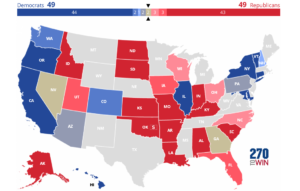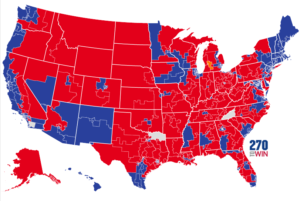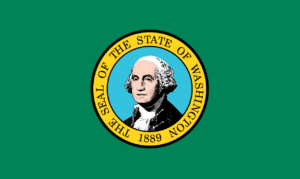As we prepare for the 2020 elections, Yesh Ginsburg and Steen Kirby will give a general overview of all 435 United States House of Representatives races. This is a basic overview to introduce you to the major candidates. All Partisan Lean numbers are taken from the Cook Partisan Voting Index. We will update this page as the races progress if anything noteworthy arises.
This group of districts contains one of California’s eight seats that Republicans won in 2018. It also has a few swing districts that the Democrats gained in 2018, so there are several races to watch here.
California is the most populous state in the nation, with its whopping 53 Congressional Districts. 45 of those currently sit in the hands of Democrats. Of the nine we’ll be looking at in this article, every single one is held by a Democrat. What will the Representatives be like from these districts? Let’s introduce them.
Remember, California runs on a “jungle primary” system. On March 3rd, every candidate interested in running for Congress appeared on the ballot. The top two in each race advanced to the November general election, so there are no write-ins and no third candidates. In some districts, the top two primary candidates are from the same party.
Because of California’s size, we are not putting every candidate in one article. In fact, it takes us six articles to get through all of them. This article looks over Districts 37-45, but we also have gone over all the other districts, linked below.
Districts 1-9
Districts 10-18
Districts 28-36
Districts 37-45
Districts 46-53
California’s 37th Congressional District
Incumbent: Karen Bass (Democrat, fifth term)
Partisan Lean: D+37
2018 Results:
| Candidate | Votes | % |
| Karen Bass (D) | 210,555 | 89.08 |
| Ron Bassilian (R) | 25,823 | 10.92 |
2016 Results:
| Candidate | Votes | % |
| Karen Bass (D) | 192,490 | 81.13 |
| Chris Blake Wiggins (D) | 44,782 | 18.87 |
Republican Candidate:
Errol Webber (campaign website)
Webber is a Jamaican immigrant campaigning against what he calls “liberal irresponsibility.” He focuses mostly on local issues, but also how federal leadership can impact local levels when not done properly. Considering that Bass got over 88% in the jungle primary, I wouldn’t set expectations too high for this campaign.
Democratic Candidate:
Karen Bass
We are not linking to Bass’s campaign website because it seems to have some sort of bug, but that’s okay because she doesn’t need a website anyway. A liberal Democrat in one of the most heavily Democratic districts in the country, her worst general election showing came in 2016… when her opponent was another Democrat. Bass is on Joe Biden’s VP shortlist.
California’s 38th Congressional District
Incumbent: Linda Sanchez (Democratic, ninth term)
Partisan Lean: D+17
2018 Results:
| Candidate | Votes | % |
| Linda Sanchez (D) | 139,188 | 68.85 |
| Ryan Downing (R) | 62,968 | 31.15 |
2016 Results:
| Candidate | Votes | % |
| Linda Sanchez (D) | 163,590 | 70.48 |
| Ryan Downing (R) | 68,524 | 29.52 |
Republican Candidate:
No Republican qualified for the general election.
Democratic Candidates:
Linda Sanchez (campaign website)
Michael Tolar
No Republican even tried for the primary in this race, so we are left with a general election between Sanchez, an establishment Democrat, and progressive challenger Michael Tolar.
Yesh’s notes: Tolar’s campaign website seems to have expired, and he is mostly campaigning on social media. His campaign has spent no money, and his Twitter feed is either endorsements of popular progressives or attacks on Republicans. Considering that he has not yet reached 500 followers on the website, I don’t think it’s been all that successful.
California’s 39th Congressional District
Incumbent: Gil Cisneros (Democrat, first term)
Partisan Lean: Even
2018 Results:
| Candidate | Votes | % |
| Gil Cisneros (D) | 126,002 | 51.56 |
| Young Kim (R) | 118,391 | 48.44 |
2016 Results:
| Candidate | Votes | % |
| Ed Royce (R) | 150,777 | 57.23 |
| Brett Murdock (D) | 112,679 | 42.77 |
Republican Candidate:
Young Kim (campaign website)
For a time, it appeared like Kim would be the first Korean-American in Congress in 2018. After the absentee ballots were all counted, though, she fell short. She’s up for a rematch, though, with a funding advantage and support from the NRCC. She’s a middle-of-the-road conservative whose main campaign focuses include the economy and immigration.
Democratic Candidate:
Gil Cisneros (campaign website)
Cisneros is the first Democrat to ever win this seat, the bulk of which is in Orange County. He is a moderate Democrat who is campaigning on more issues than most, including his push for animal and pets rights. His website also has the distinction of being available in three languages.
Yesh’s notes: It’s always hard to project from a primary to the general election, but Kim performed better in Orange County in the 2020 primary than in the 2018 general election. She’ll need to run up the margin a bit there to outweigh the rest of the district, which leans left. But the primary bodes well for her.
Steen’s notes: If Trump wasn’t on the ballot with her, Kim would almost certainly win, but for now given Trump’s terrible standing in this district Cisneros remains the favorite, even if he’s holding the seat on borrowed time and Kim is one of the better NRCC candidates this cycle.
California’s 40th Congressional District
Incumbent: Lucille Roybal-Allard (Democrat, 14th term)
Partisan Lean: D+33
2018 Results:
| Candidate | Votes | % |
| Lucille Roybal-Allard (D) | 93,938 | 71.46 |
| Rodolfo Cortes Barragan (G) | 25,511 | 28.54 |
2016 Results:
| Candidate | Votes | % |
| Lucille Roybal-Allard (D) | 106,554 | 81.36 |
| Roman Gonzalez (I) | 24,473 | 18.64 |
Republican Candidate:
C. Antonio Delgado (campaign website)
Delgado is the first Republican to reach the general election in this district since the jungle primary system began. However, he is not your typical Republican. He says he models himself after Kevin McCarthy (presumably referring to the current California Republican, not the Iowa or Illinois Democrat who share the name). He also says, though, that getting rid of the influence of money in politics is his biggest issue, and his political philosophy is modeled after Robert Reich’s Saving Capitalism.
Democratic Candidate:
Lucille Roybal-Allard (campaign website)
Roybal-Allard is an establishment Democrat who votes with the party consistently. She has never really been challenged for the seat, and consistently runs on her record of passing Democratic legislation through Congress.
California’s 41st Congressional District
Incumbent: Mark Takano (Democrat, fourth term)
Partisan Lean: D+12
2018 Results:
| Candidate | Votes | % |
| Mark Takano (D) | 108,227 | 65.1 |
| Aja Smith (R) | 58,021 | 34.9 |
2016 Results:
| Candidate | Votes | % |
| Mark Takano (D) | 128,164 | 64.95 |
| Doug Shepherd (R) | 69,159 | 35.05 |
Republican Candidate:
Aja Smith (campaign website)
Smith is trying to run a grassroots conservative campaign, mainly focused on fighting what she views as liberal overreach. She has very little institutional support, but she does have a large number of small donors. It’s not going to be enough to win this race, but if she can cut down the gap a bit maybe she can make it close and get more support in 2022.
Democratic Candidate:
Mark Takano (campaign website)
Takano has removed the “issues” page from his campaign website, but voters know who he is and what he’s about. He’s a middle-of-the-road Democrat in a Democratic-leaning district. And considering his opponent’s support for President Trump, that’s likely really all he needs.
California’s 42nd Congressional District
Incumbent: Ken Calvert (Republican, 14th term)
Partisan Lean: R+9
2018 Results:
| Candidate | Votes | % |
| Ken Calvert (R) | 131,040 | 56.5 |
| Julia Peacock (D) | 100,892 | 43.5 |
2016 Results:
| Candidate | Votes | % |
| Ken Calvert (R) | 149,547 | 58.82 |
| Tim Sheridan (D) | 104,689 | 41.18 |
Republican Candidate:
Ken Calvert (campaign website)
Calvert is one of the longer-tenured Republicans in Congress, and he’s looking to get elected again. He’s campaigning on a relatively conservative slate of lower taxes, immigration reform, and conservative healthcare responses.
Democratic Candidate:
Liam O’Mara (campaign website)
O’Mara is running one of the most unique progressive campaigns we’ve ever seen. He has lengthy positions articulated on dozens of issues. And while the general policies are always progressive, he does not go along with the “party line.” He endorses the goals of the Green New Deal, but implies he would support somewhat different ways of reaching them. He does similar with his stance on Medicare for All. He also has detailed opinions on minimum wage, UBI, LGBTQIA+ issues, Native issues, and much more.
Yesh’s notes: I have pointed this out about several Republicans, but O’Mara is another example of a potentially very strong candidate who is running in a district that seems far from the most conducive for them to win. (Aja Smith in the 41st district is another example, and Joe Collins in the 43rd might be the best example of them all.)
California’s 43rd Congressional District
Incumbent: Maxine Waters (Democrat, 15th term)
Partisan Lean: D+29
2018 Results:
| Candidate | Votes | % |
| Maxine Waters (D) | 151,272 | 77.67 |
| Omar Navarro (R) | 43,780 | 22.33 |
2016 Results:
| Candidate | Votes | % |
| Maxine Waters (D) | 167,017 | 76.08 |
| Omar Navarro (R) | 52,499 | 23.92 |
Republican Candidate:
Joe Collins (campaign website)
Collins is a pro-Trump veteran who served in the Navy for 13 years. He is running a moderate conservative campaign that is almost entirely focused on local issues.
Yesh’s notes: Whether or not he wins this race (winning is obviously exceedingly unlikely), Collins has gained large social media followings and numerous appearances on right-wing media out of this run. He has a future in the Republican Party somewhere, but it’s not in a D+33 district.
Democratic Candidate:
Maxine Waters (campaign website)
Waters’s campaign website is just a chance to donate or sign up for emails, but she doesn’t need to do more. Her district knows her and, if election results are any indication, still appreciates what she does in Congress. Right-wing media can focus bad press on her all they want; it’s obvious that has had no real impact within the district.
California’s 44th Congressional District
Incumbent: Nanette Barragan (Democrat, second term)
Partisan Lean: D+35
2018 Results:
| Candidate | Votes | % |
| Nanette Barragan (D) | 97,944 | 68.34 |
| Aja Brown (D) | 45,378 | 31.66 |
2016 Results:
| Candidate | Votes | % |
| Nanette Barragan (D) | 93,124 | 52.2 |
| Isadore Hall (D) | 85,289 | 47.8 |
Republican Candidate:
No Republican qualified for the general election.
Democratic Candidates:
Nanette Barragan (campaign website)
Analilia Joya
Joya, as far as we could find, is not actually running a campaign. There is no website, no fundraising data, and no social media. Barragan is a liberal Democrat, and one of the few non-progressives to tout an endorsement from Bernie Sanders.
California’s 45th Congressional District
Incumbent: Katie Porter (Democrat, first term)
Partisan Lean: R+3
2018 Results:
| Candidate | Votes | % |
| Katie Porter (D) | 158,906 | 52.05 |
| Mimi Walters (R) | 146,383 | 47.95 |
2016 Results:
| Candidate | Votes | % |
| Mimi Walters (R) | 182,408 | 58.58 |
| Ron Varasteh (D) | 128,996 | 41.42 |
Republican Candidate:
Greg Raths (campaign website)
Raths is trying to win back the seat that Porter claimed in 2018, and he is going about it in a very different way than Walters did. He is not campaigning on support for President Trump. He is mostly focusing on foreign policy, including on how to move forward in dealing with China and Iran. He also has moderate conservative proposals for healthcare, and is campaigning to lower taxes.
Democratic Candidate:
Katie Porter (campaign website)
Porter is very quickly becoming a rising star in the Democratic Party, and she is respected and well-liked by both the progressive and establishment wings. She supports some progressive policies, like Medicare for All, but not the entire progressive platform. She has a massive fundraising advantage in this race, which we should expect her to use given the primary results. She earned just over 50%, but every single other primary candidate was a Republican.
Steen’s Notes: Raths is a deeply flawed candidate, and despite being on the left side of the party, Porter is practically safe to win a second term.
Overview
There are a few noncompetitive districts in this group, but overall there are more than the usual number of compelling candidates, and some of these races could be very close.
Interested in the rest of our primers for other House races? We have them all listed on our primer home page.







